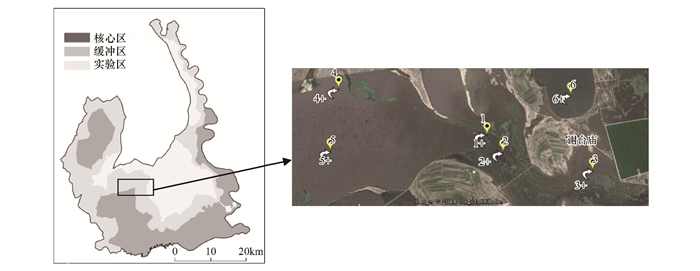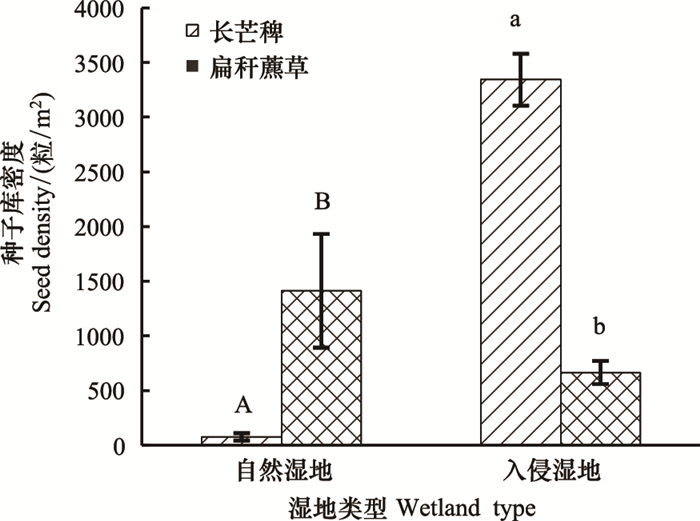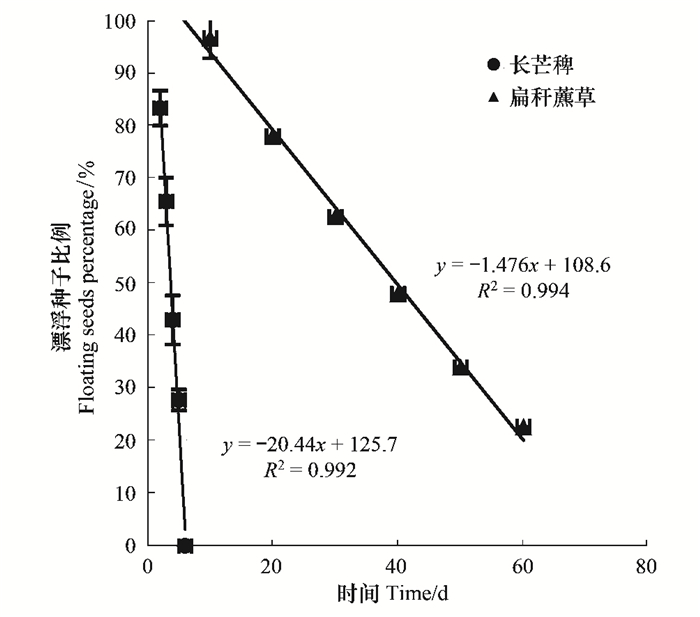文章信息
- 刘波, 吕宪国, 姜明, 张文广, 武海涛, 于珊珊
- LIU Bo, Lü Xianguo, JIANG Ming, ZHANG Wenguang, WU Haitao, YU Shanshan
- 莫莫格扁秆藨草恢复湿地土壤种子库对长芒稗入侵的响应
- Response of soil seed banks to invasion by Echinochloa caudata in restored Scirpus planiculmis wetlands in the Momoge National Nature Reserve
- 生态学报, 2016, 36(8): 2217-2222
- Acta Ecologica Sinica, 2016, 36(8): 2217-2222
- http://dx.doi.org/10.5846/stxb201410172043
-
文章历史
- 收稿日期: 2014-10-17
- 网络出版日期: 2015-08-24
2. 中国科学院大学, 北京 100049
2. University of Chinese Academy of Sciences, Beijing 100049, China
土壤种子库作为过去植物群落的“记忆”,是植被自然恢复的重要潜力,尤其对于一些珍稀濒危植物更为重要[1, 2]。退化湿地的植被重建能力是评估湿地恢复成功与否的关键指标之一[3],土壤种子库作为潜在的植物群落,影响植被的物种组成、空间结构和演替动态[4],因此,土壤种子库对于成功恢复湿地也具有重要的指示作用[5]。在美国Kenilworth沼泽研究表明,自然湿地重要物种假泽兰(Mikania scandens)和箭头蓼(Polygonum sagittatum)在恢复10a湿地很少或没有出现,说明尽管湿地恢复已达10a,种子库仍没有恢复到其原始状态[6]。
扁秆藨草是莫莫格湿地的重要植物,也是白鹤在该地停栖的主要食源植物[7]。由于气候变化和人类活动的影响,扁秆藨草湿地退化严重。当地从2010年开始生态补水以恢复白鹤栖息生境。然而,在恢复两年湿地扁秆藨草很少出现,而一年生植物长芒稗快速扩展,在大部分区域成为建群种。与扁秆藨草相比,长芒稗在研究区生长高大(1.3—1.7m),覆盖度达70%—80%,说明长芒稗在地表植物群落明显占优势(未发表数据);不过有关两者地下植物群落的研究还未见报道。
在湿地生态系统,种子水传播对于种子库形成十分重要[6]。种子浮力高的植物通过水传播而扩散的能力更强,在维系群落动态和植被恢复方面起重要作用[8]。然而,关于种子浮力与种子库特征关系方面的研究还不多见。种子在水传播过程中,容易受到植物体等的机械阻碍而搁浅[9]。在问题物种入侵严重的湿地,由于其生长高大、致密,且凋落物大量积累[10],势必影响种子水传播格局。
针对莫莫格受长芒稗入侵严重的恢复湿地,拟回答以下问题:(1) 长芒稗入侵湿地土壤种子库有何特征(2)长芒稗与扁秆藨草种子库格局的形成机制;以期为控制长芒稗、促进扁秆藨草恢复提供科学依据。
1 研究地区与研究方法 1.1 研究地区概况莫莫格湿地位于吉林省镇赉县境内,面积约为14.4万 hm2,位于松辽沉降带的北段,地理坐标为北纬45°45′—46°10′,东经122°27′—124°04′,属于嫩江及其支流冲积而成的低平原,平均海拔142m;研究区气候属温带大陆性季风气候,年平均气温4.2℃,年蒸发量1 553mm,年降水量391.88 mm,降水主要集中在6—8月,占全年降水量的76.6%[7]。
莫莫格鹅头泡湿地是白鹤在该区停歇的主要区域,也是受长芒稗影响严重的湿地。该湿地是一个半封闭的湿地区,内部水分自然流通(图 1)。野外调查发现,恢复两年湿地大部分区域为长芒稗群落,也存在少量扁秆藨草残余湿地(自然湿地),水深一般在5—30cm;常见湿地植物有长芒稗、扁秆藨草、三江藨草(Scirpus nipponicus)、水葱(S. validus)、芦苇(Phragmites australis)、狸藻(Utricularia vulgaris)和碱蓬(Suaeda glauca)等。研究区土壤理化性质详见文献[11]。

|
| 图 1 研究区在莫莫格保护区的位置和植物群落取样点位置。 Fig.1 Location of the study site in the Momoge NNR and Location of the sampling plots |
为了获取研究区持久性土壤种子库信息,在2012年6月下旬(即种子萌发高峰已过,当年植物种子尚未成熟或扩散的时间)取样。根据扁秆藨草残余湿地的实际分布情况,在研究区内选择6个自然湿地斑块(图 1),在小斑块中央设一个5m×5m样地;在每个斑块附近长芒稗群落内设一个5m×5m样地,所有样地的水位基本一致(10—20cm),样地内植物长势一致。在样地中央取一个0.5m×0.5m样方,在小样方内用直径7cm的采样器各随机取3次,混合为一份样品,共采集12份样品,采集土壤表面积共1384.74cm2;取样深度参考研究区已有研究结果[11],取0—10cm土壤样品。
鉴于扁秆藨草和长芒稗种子体积较大,容易辨识,样品采集完后,立即用漂洗法进行物理分选。统计并保存每份样品中的植物种子。针对每份样品中的扁秆藨草和长芒稗种子各随机抽取50粒(不足50粒的,取所有种子),用TTC法测定其活力。
1.2.2 地表植被调查在上述取土壤样品的样方附近各设1m×1m样方1个(共12个),进行地表群落调查。考虑到扁秆藨草和长芒稗结实时间不同,分别在7月初和8月中旬进行两种群落的样方调查。调查指标包括植物种类、高度、盖度及长芒稗和扁秆藨草结实植株数量;在样方周围每物种各选30茎秆和50小穗,分别统计每茎小穗数和每穗种子数量,以计算单位面积结实量。单位面积结实量=单位面积结实茎数×每茎平均小穗数×每穗平均种子数量(表 1)。
| 项目 Project | 长芒稗 E. caudata | 扁秆藨草 S. planiculmis |
| 同一行不同小写字母表示差异显著, P=0.05 | ||
| 植株高度 Plant height/cm | 110.83±17.57a | 68.33±10.49b |
| 植被盖度 Vegetation cover/% | 75.00±4.35a | 30.00±6.24b |
| 单位面积结实茎数 No. of fruit-stems | 91.40±4.51 | 61.60±10.12 |
| 每茎小穗数 Panicle no. per stem | 18.53±1.73 | 5.60±0.19 |
| 每穗种子数 Seed no. per panicle | 4.50±0.43 | 26.70±1.01 |
| 种子生产力/(粒/m 2) Seed production | 7621.40±376.25a | 9210.40±1513.4a |
分别于7月中旬和8月下旬采集扁秆藨草和长芒稗的种子。每个物种随机选取50株健康植株,采集整个小穗,回室内后,去除果皮等杂质,挑选饱满的种子风干备用。
9月份在静水中进行植物种子浮力测试。每物种各选取3份50粒种子,放入盛有蒸馏水的烧杯中,搅拌使所有种子接触到水。以后每天记录下沉种子的数量,补充水分并搅拌。
1.3 数据处理将每份样品中有活力种子的数量扩展到1m2的面积上,采用成组数据t检验分析不同物种及湿地类型对种子库大小的影响,分析长芒稗与扁秆藨草在株高、覆盖度及结实量方面的差异。种子浮力特征采用维持一定漂浮种子比例(floating percentage,FP%)所需要的时间(d)来表示[8],如FP50表示在水中仍有50%种子漂浮所需要的时间,时间越长表示种子浮力越高;通过线性回归分析建立FP%与时间之间的定量关系。所有数据分析在SPSS16.0和Excel软件下进行。
2 结 果 2.1 恢复湿地土壤种子库特征本研究共发现6种植物,其中一年生草本3种,分别是长芒稗、尖头叶藜(Chenopodium acuminatum)和碱蓬(S. glauca);多年生草本3种,分别是三江藨草(S.nipponicus)、扁秆藨草和水葱(S. validus)。
长芒稗和扁秆藨草的种子库规模在两类湿地呈现明显不同的格局(图 2),在自然湿地扁秆藨草种子密度是长芒稗的18.42倍,而在入侵湿地长芒稗种子密度是扁秆藨草的5.04倍。在入侵湿地,有活力长芒稗种子的密度高达(3345.9±520.3)粒/m2,明显高于自然湿地的密度(t=-6.27,P<0.01);扁秆藨草种子库密度在自然湿地为(1413.16±237.8)粒/m2,显著高于入侵湿地的种子库密度(t=2.88,P<0.05)。

|
| 图 2 莫莫格恢复湿地长芒稗和扁秆藨草土壤种子库密度 Fig.2 Seed bank density of Echinochloa caudata and Scirpus planiculmis in Momoge restored wetland 图中大写字母或小写字母不同表示差异达到显著性水平,P=0.05 |
由表 1可以看出,长芒稗植株高度和覆盖度均显著大于扁秆藨草。在入侵湿地,单位面积长芒稗结实植株数量占总植株数的93.41%;在自然湿地,扁秆藨草结实植株占总植株数的20.76%。在单位面积结实量方面,长芒稗和扁秆藨草无明显差异。
2.3 长芒稗和扁秆藨草种子浮力特征漂浮种子比例随时间变化的趋势如图 3所示。长芒稗种子在静水中浸水5 d后已全部下沉,漂浮种子剩余50%仅用了不到4d时间(FP50=3.7d)。扁秆藨草种子浮力较强,浸水约40d后仍然有一半种子漂浮(FP50=39.7d)。

|
| 图 3 长芒稗和扁秆藨草种子在静水中的下沉速率 Fig.3 Seed sinking rate of Echinochloa caudata and Scirpus planiculmis in standing water |
土壤种子库作为繁殖体的储备库,在植被演替更新和受损湿地恢复中起着十分重要的作用[12]。在以恢复某一种群或群落为目标时,研究其土壤种子库特征对于指导湿地植被恢复实践有重要意义[13]。Kettenring 和 Galatowitsch[14]比较了在采用自然和人工恢复方法后的湿地土壤种子库,发现自然植被莎草属植物的种子在土壤中非常少;在我国南四湖退耕地也发现种子库中缺失自然湿地常见的挺水植物,需要通过播种或栽苗补充植物物种[15]。与之相反,在本研究尽管长芒稗在入侵湿地地表植被中占优势,但土壤中仍存在一定量有活力的扁秆藨草种子,说明可以利用土壤种子库进行扁秆藨草的恢复。
土壤种子库研究也可以检验恢复湿地是否受非目标种入侵的影响[2],为植被恢复调控提供可靠信息。在美国中部壶穴湿地,退耕还湿3年后种子库缺失该地区莎草沼泽一些常见植物(如薹草)的种子,而一年生植物在土壤中占优势[16];在我国三江平原的研究也表明,一年生杂草宽叶山蒿(Artemisia stolonifer)在恢复湿地土壤中占优势[12]。与之类似,本研究发现入侵湿地土壤中存在大量有活力的长芒稗(一年生禾草)种子,这与完全黑暗条件下部分长芒稗种子萌发被限制有关(未发表数据)。土壤中大量非目标植物种子的存在,预示着其在未来地表植被中仍然占优势,进一步限制自然植被的恢复。
在湿地生态系统,尤其是有一定地表水位的湿地,较高的浮力增强了种子水播的可能性[8]。扁秆藨草种子浮力较强,在水中漂浮的种子能够随水流进行中长距离传播,并且扁秆藨草种子具有休眠特性(即,在当年水传播过程中不会萌发),这为扁秆藨草种子库的形成及物种扩散提供了可能。莫莫格鹅头泡湿地绝大部分区域保持有一定地表水位,且分布着一定面积的扁秆藨草群落,再考虑到扁秆藨草较高的种子生产力和土壤种子库,这为该区域扁秆藨草的恢复提供了种源保障。与扁秆藨草相反,长芒稗种子的浮力较弱,这应是长芒稗种子在入侵湿地远远高于自然湿地的重要原因。
与其他湿地问题物种类似,长芒稗也具有生长高大、致密的特点。大量植物体的存在阻碍了种子的水传播,限制了扁秆藨草的扩散。并且,凋落物的大量累积降低了到达地表的光照水平,改变了地表温度及其变化范围[10]。与长芒稗不同,扁秆藨草适应遮荫条件的能力弱[17],因此,长芒稗的生长扩展对自身种子萌发影响不大,却极大地限制了扁秆藨草的更新。尽管这在一定程度上能够保存土壤中的扁秆藨草种子,使其在条件合适时萌发,但也容易使其遭受土壤生物的侵害,降低种子的活力和种子库规模。因此,在长芒稗入侵初期,于开花结实前及时进行清除处理,应是限制其种子库发展,同时促进扁秆藨草种群更新的重要措施。
致谢: 本研究野外取样工作得到了莫莫格国家级自然保护区邹畅林、王波和孟庆祥等工作人员的支持和帮助,样点分布图由中国科学院东北地理与农业生态研究所的刘春悦博士提供,在此一并表示感谢。| [1] | Nishihiro J, Nishihiro M A, Washitani I. Assessing the potential for recovery of lakeshore vegetation: Species richness of sediment propagule banks. Ecology Research, 2006, 21(3): 436-445. |
| [2] | Faist A M, Ferrenberg S, Collinge S K. Banking on the past: seed banks as a reservoir for rare and native species in restored vernal pools. AoB PLANTS, 2013, 5: plt043. |
| [3] | Middleton B A. Soil seed banks and the potential restoration of forested wetlands after farming. Journal of Applied Ecology, 2003, 40(6): 1025-1034. |
| [4] | 李伟, 刘贵华, 周进, 黄德四. 淡水湿地种子库研究综述. 生态学报, 2002, 22(3): 395-402. |
| [5] | 崔娜欣, 吴娟, 成水平, 周琪. 湿地种子库及其植被恢复研究进展. 湖泊科学, 2013, 25(1): 1-8. |
| [6] | Neff K P, Rusello K, Baldwin A H.Rapid seed bank development in restored tidal freshwater wetlands. Restoration Ecology, 2009, 17(4): 539-548. |
| [7] | 惠淑荣, 李响, 张志翔, 宁宇. 土壤含盐量对扁杆藨草生长的影响. 辽宁林业科技, 2009, (1): 25-28. |
| [8] | van denBroek T, van Diggelen R, Bobbink R. Variation in seed buoyancy of species in wetland ecosystems with different flooding dynamics. Journal of Vegetation Science, 2005, 16(5): 579-586. |
| [9] | Chambert S, James C S J. Sorting of seeds by hydrochory. River Research and Applications, 2009, 25(1): 48-61. |
| [10] | Larkin D J, Freyman M J, Lishawa S C,Geddes P, Tuchman N C. Mechanisms of dominance by the invasive hybrid cattail Typha×glauca. Biological Invasions, 2012, 14(1): 65-77. |
| [11] | 宁宇, 张志翔, 赵良成, 邹畅林, 杨佳妮. 克隆植物扁秆藨草种子库特征及其适应意义. 湿地科学, 2014, 12(1): 55-60. |
| [12] | 王国栋, Middleton B A, 吕宪国, 姜明, 王铭, 赵魁义, 娄彦景. 农田开垦对三江平原湿地土壤种子库影响及湿地恢复潜力. 生态学报, 2013, 33(1): 205-213. |
| [13] | Wang N, Jiao J Y, Du H, Wang D L, Jia Y F, Chen Y. The role of local species pool, soil seed bank and seedling pool in natural vegetation restoration on abandoned slope land. Ecological Engineering, 2013, 52(2): 28-36. |
| [14] | Kettenring K M, Galatowitsch S M. Seed rain of restored and natural prairie wetlands. Wetlands, 2011, 31(2): 283-294. |
| [15] | Ge X L, Wang R Q, Zhang Y R, Song B M, Liu J. The soil seed banks of typical communities in wetlands converted from farmlands by different restoration methods in Nansi Lake, China. Ecological Engineering, 2013, 60(6): 108-115. |
| [16] | Mulhouse J M, Galatowitsch S M. Revegetation of prairie pothole wetlands in the mid-continental US: twelve years post-reflooding. Plant Ecology, 2003, 169(1): 143-159. |
| [17] | 钱希. 扁秆藨草的生物学及其防除. 植物保护学报, 1988, 10(2): 119-125. |
 2016, Vol. 36
2016, Vol. 36




